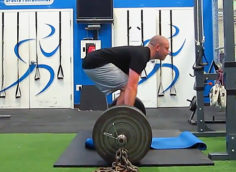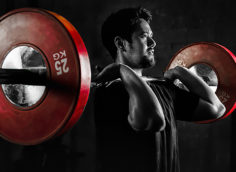Slouchers, Do the T-W-A-Y Circuit
Many lifters experience shoulder pain. This is often due to faulty biomechanics or weakness/inactivity of the scapular stabilizers (serratus anterior, rhomboids, levator scapulae and trapezius).
Most commonly, anterior shoulder pain (in the front of the shoulder) will be due to difficulty fully retracting the scapulae. Much like the glute amnesia caused by prolonged sitting, scapular retractors can be hard to properly recruit after we sit slouched for hours. Because our shoulder blades tend to move into protraction (up and forward) when posture is less than ideal, you need to retrain your retractors to pull your shoulder blades down and back.
The challenge is finding scapular retraction exercises in which the bigger, stronger muscles of the shoulder girdle won't overpower their smaller counterparts. These exercises will help to combat the problem. Not only will they help lifters with shoulder stability for pain-free benching and overhead pressing, they're also of great benefit for injury prevention in overhead movement athletes.
All four exercises will be performed in a prone lying position. Take a breath to expand and stabilize the rib cage, lifting the sternum and head to achieve proper cervical and thoracic alignment. The range of motion will be minimal, which allows you to better target the scapular retractors. Maintain constant tension on the target muscles throughout the movement and between reps for maximum time under tension – don't put your arms back down until all the reps are done.
These movements are much more challenging than appear, so you'll perform them with absolutely no load at first. Focus on movement control, squeezing the shoulder blades for a good strong peak contraction.
The T

Start with your arms straight out beside you in external rotation, thumbs up, forming a T-shape. Your upper arms should form a perfect 90 degree angle with your torso. Keeping your arms straight, lift your arms straight up while squeezing your shoulder blades together as hard as you can. Hold for a 3-second peak contraction. Repeat for 8-12 reps.
The W

Begin by extending your arms (palms down) up to 10 and 2 o'clock. Bend your elbows down and back as if you were trying to put your elbows in your back pockets (W-shape), focusing on a maximal contraction of the scapulae. Hold for a 3-second peak contraction. Repeat for 8-12 reps.
The A


Put your arms down alongside your torso (palms up) at about 5 and 7 o'clock (A-shape). Leading with the shoulder blades, lift your straight arms up and back as if you were trying to push off from a wall. Squeeze your scapulae hard and hold for 3 seconds. Repeat for 8-12 reps.
The Y

Extend your arms up (palms down) to about 10 and 2 o'clock (Y-shape). Leading with the hands, lift your straight arms up, while squeezing the shoulder blades back and down. Hold for 3 seconds and repeat 8-12 times.
- Perform all four exercises as a circuit at least two or three times per week. You can do them as a warm-up, at the end of an upper body workout, or even at home on the living room floor.
- In week 1, one set of each exercise will suffice. You'll be surprised how tough they are. If the exercises seem too easy, you're not trying. Focus on the squeeze. Add a second circuit in week 2 or 3 and then a third in week 3 or 4. Rest only 30 seconds or so between circuits.
- Resist the temptation to add load initially. You need to focus on maximally contracting the target muscles that drive full scapular retraction. You could easily cheat the movement up under load, but you won't develop the proper mind-muscle connection you need to get the retractors firing.
- Once you've mastered recruiting the proper musculature, you can add a small load. Start with a 2.5 pound plate in each hand. If you go too heavy, other muscles will take over the movement and then you're wasting your time. For the W, gravity is pulling in the wrong direction. Instead of using weights, anchor a low-resistance band to something stable a little way from your head, grab both ends and perform the movement as described above.





